AS RECENTLY as 2004, 50,533 fans packed out Docklands Stadium for the pre-season Grand Final between St Kilda and Geelong.
Less than two decades on, no silverware is on offer, and the AFL is considering abandoning pre-season matches altogether.
So what happened? How did pre-season footy gain its glamour, and why did the lustre fade?
From a trophy for also-rans to Brendan Fevola's 'Norm Smith', by way of Bruce Doull losing his cool, here is a look at the storied rise and fall of the competitive pre-season game.
The Night Series is born, and becomes a logistical nightmare
In 1956 the traditionally conservative Victorian Football League (VFL, now AFL) dipped a toe in experimental waters.
Inspired by a similar competition that had operated in Adelaide for the previous two years, the VFL Night Premiership was politely termed a 'consolation' competition.
In reality, it was the battle of the also-rans, comprising the eight teams that failed to qualify for the final four. And yet it captured the imagination of the footy-loving public.
Hawthorn legend Don Scott in Night Series action. All pictures: AFL Photos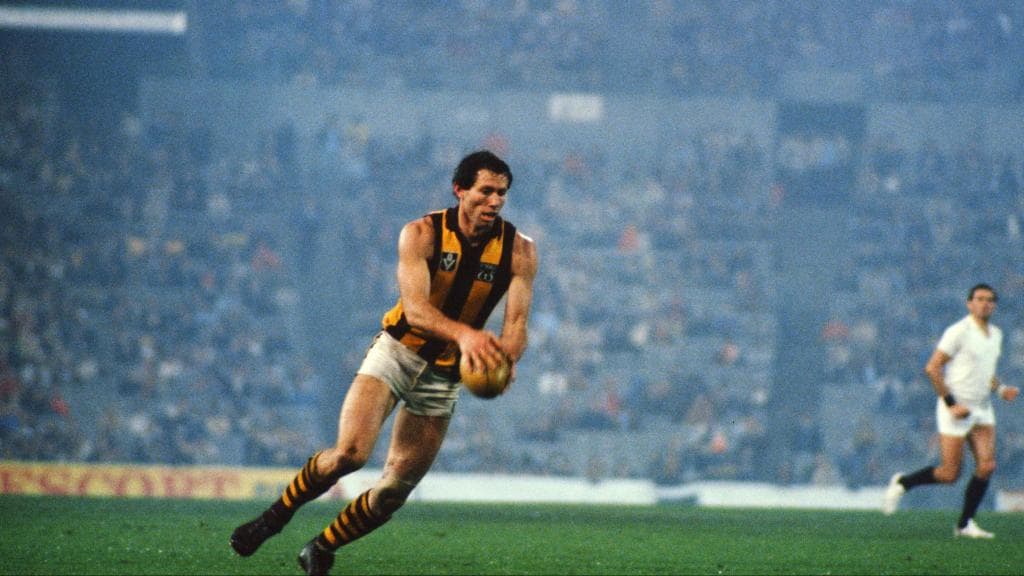
The knockout series was played on weeknights for the duration of the finals series.
The venue was South Melbourne's home ground, the Lake Oval – the only League stadium with lights of sufficient quality to host night games. It regularly drew crowds of more than 20,000, and was brimming with almost double that figure for some grand finals.
After a successful first season, the participants reaped significant financial rewards and consequently, all 12 clubs competed the next year, with finallists entering the competition after their premiership seasons had ended.
It was no great surprise that this proved a logistical nightmare and so normal programming resumed for the next 14 years.
One of the beauties of the night series was the rare shot at success it afforded traditional battlers.
The Bulldogs won the most titles with four (1963-64, 1967, 1970), followed by the Swans' three (1956-57 and 1960, the latter under the captaincy of club legend Bob Skilton) and two apiece to North Melbourne (1965-66) and Hawthorn (1968-69). St Kilda also won one in 1958.
Essendon's 1993 Foster's Cup (left) and 1962 VFL Premiership Cup.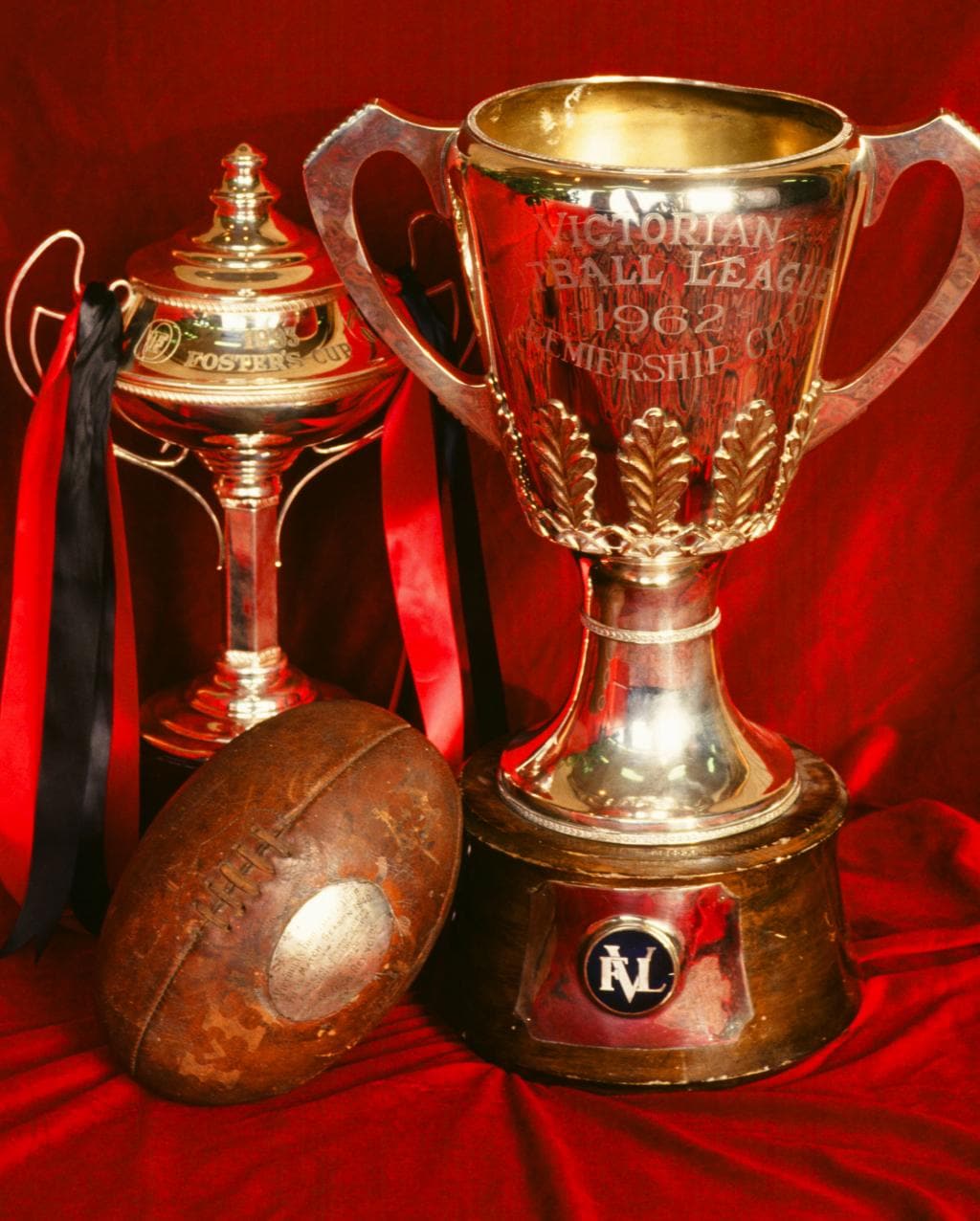
As the premiership season was lengthened – from 18 to 20 rounds in 1968 and then to 22 rounds in 1971 – fans and clubs alike began to turn away from the concept. The death knell was the introduction of the final five system, which would have left just seven competing teams.
The night series was abandoned after 1971, but not before proving a valuable testing ground for new rules. They included a free kick for a kick out of bounds on the full, and the centre diamond, which would later pivot to become a square.
| Season | Grand Final winner | Runner-up | Grand Final crowd |
| 1956 | South Melbourne | Carlton | 32,450 |
| 1957 | South Melbourne | Geelong | 25,000 |
| 1958 | St Kilda | Carlton | 26,400 |
| 1959 | Fitzroy | Hawthorn | 9,200 |
| 1960 | South Melbourne | Hawthorn | 20,000 |
| 1961 | Geelong | North Melbourne | 30,365 |
| 1962 | Richmond | Hawthorn | 24,550 |
| 1963 | Footscray | Richmond | 25,270 |
| 1964 | Footscray | St Kilda | 36,300 |
| 1965 | North Melbourne | Carlton | 37,750 |
| 1966 | North Melbourne | Hawthorn | 22,800 |
| 1967 | Footscray | South Melbourne | 26,731 |
| 1968 | Hawthorn | North Melbourne | 15,650 |
| 1969 | Hawthorn | Melbourne | 21,067 |
| 1970 | Footscray | Melbourne | 23,882 |
| 1971 | Melbourne | Fitzroy | 21,169 |
Mid-week footy goes national, and Robbert Klomp scores a television
After five seasons without a night competition, the VFL once again took its lead from a series held under lights in Adelaide.
In 1976 a national night competition featuring the cream of teams from the VFL, SANFL and WAFL took centre stage mid-week during winter. The games were nationally televised, with Hawthorn claiming top honours.
The next year the VFL created its own version of that sudden-death series, using a yellow ball for the first time (replacing white) in Tuesday night games at Waverley that were telecast on Channel Seven.
Despite some early lighting problems, the competition became a staple footy fix for fans.
Memorable moments included:
- Essendon star Tim Watson leaping over fallen players and kicking an iconic goal in the Bombers' 1981 triumph over Carlton
- Blues superstar defender Bruce Doull uncharacteristically losing his cool when Hawthorn opponent Kevin Ablett stole his headband in the 1977 night grand final
- Carlton's Robbert Klomp being awarded a television by Channel Seven after being adjudged best-afield despite having just nine touches.
Don't touch the headband: Bruce Doull.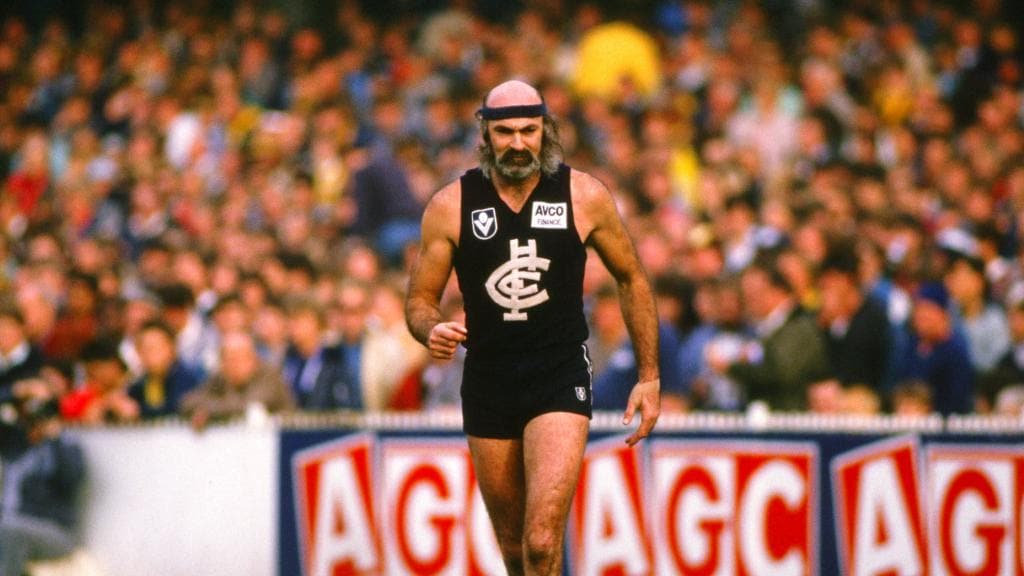
There was no greater controversy, though, than when Collingwood was robbed of the 1980 title. The siren had sounded when North Melbourne forward Kerry Good marked, but the mark was paid and he slotted the match-winning goal.
Initially only VFL teams participated but the competition quickly grew to include 34 teams. The bulk of them hailed from outside Victoria, including WAFL club Swan Districts, which sent a reserves team to face Richmond in a 1982 final because coach John Todd feared it would affect their WAFL campaign.
The result? A 186-point drubbing and a two-year ban from the series.
The League's powerhouse teams of the era such as Hawthorn, Essendon and Carlton generally took the honours, but fans of Fitzroy (1978), Swans (1982) and Melbourne (1987) celebrated drought-breaking victories in the series.
| Season | Grand Final winner | Runner-up | Grand Final crowd |
| 1977 | Hawthorn | Carlton | 27,407 |
| 1978 | Fitzroy | North Melbourne | 26,420 |
| 1979 | Collingwood | Hawthorn | 37,753 |
| 1980 | North Melbourne | Collingwood | 50,478 |
| 1981 | Essendon | Carlton | 42,269 |
| 1982 | Sydney | North Melbourne | 20,028 |
| 1983 | Carlton | Richmond | 32,927 |
| 1984 | Essendon | Sydney | 30,824 |
| 1985 | Hawthorn | Essendon | 24,812 |
| 1986 | Hawthorn | Carlton | 19,627 |
| 1987 | Melbourne | Essendon | 26,860 |
Pre-season winners are grinners
The transformation of the night series into a pre-season competition was more evolutionary than revolutionary.
By 1987 the night series was exclusively contested by VFL teams and finished in April, early in the premiership season, so in 1988 the League repackaged the concept as a purely pre-season competition.
The initiative proved a hit with fans who savoured footy in the warmer weather at Waverley, which had become known as 'Arctic Park' because of its notoriously cold and windy winter nights.
The footy was hot, too. Premierships of any kind were still cherished and clubs generally fielded strong line-ups. In the competition's embryonic phase, the powerful Hawthorn and Essendon almost monopolised the pre-season flags.
The baby Bombers reigned in the pre-season in 1993 ...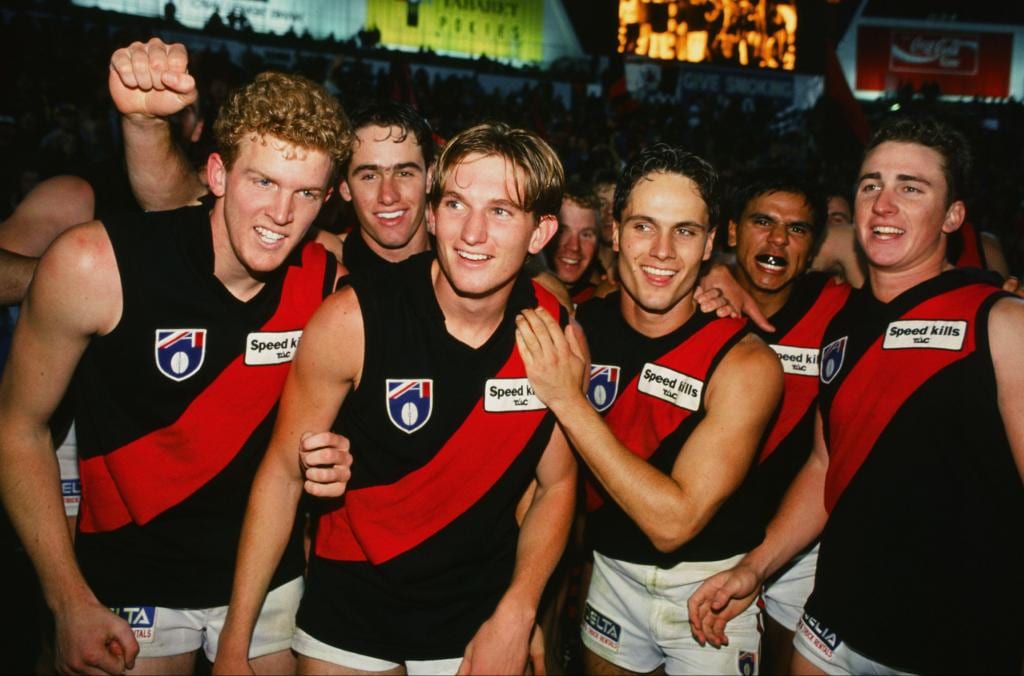
... and again in 1994.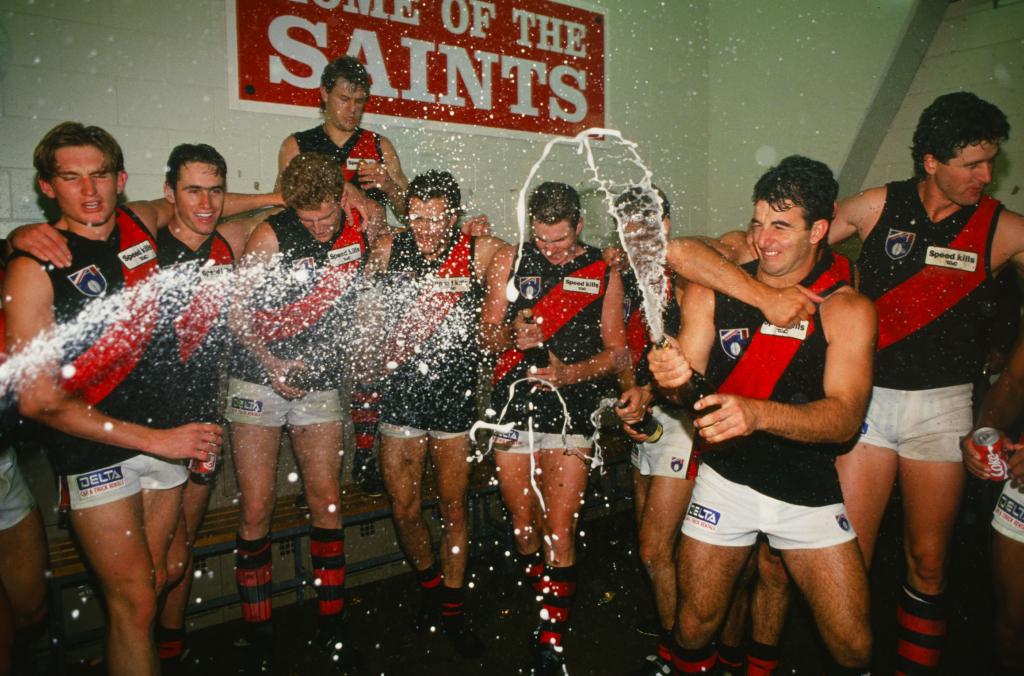
Hawks Paul Hudson (left) and John Platten with their 1992 Foster's Cup spoils.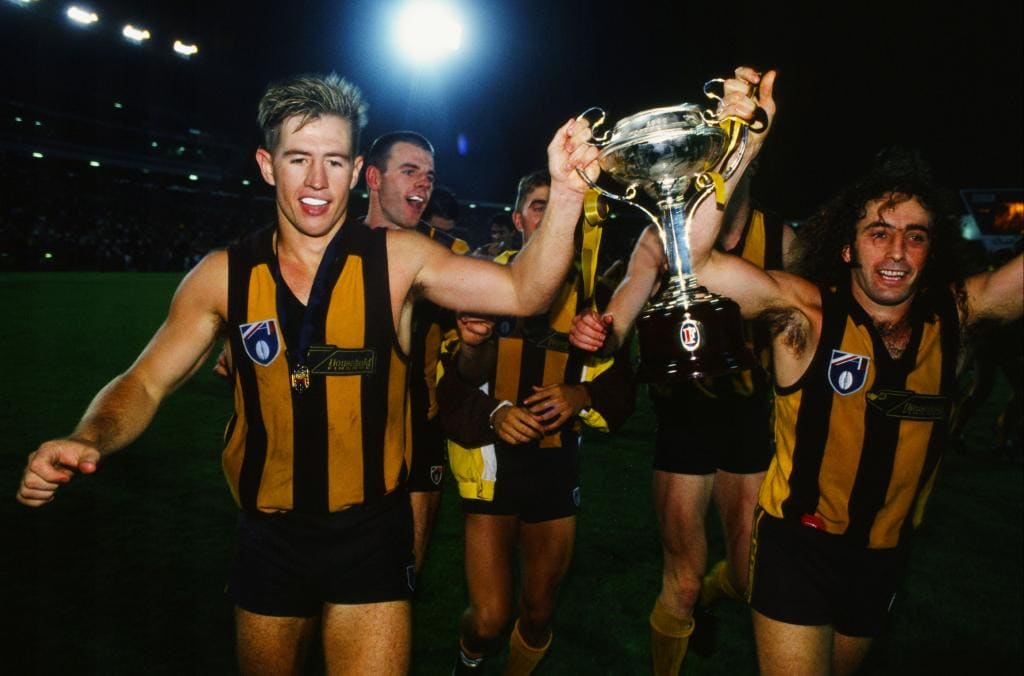
The knockout format continued until 1999 before being changed to a round-robin series involving multiple conferences, with the rationale that it would provide a fairer season preparation for all clubs. Not everyone agreed, though, and sudden-death was again in vogue from 2003-10.
Saint Nicky Winmar is a grinning winner with the 1996 Ansett Cup ...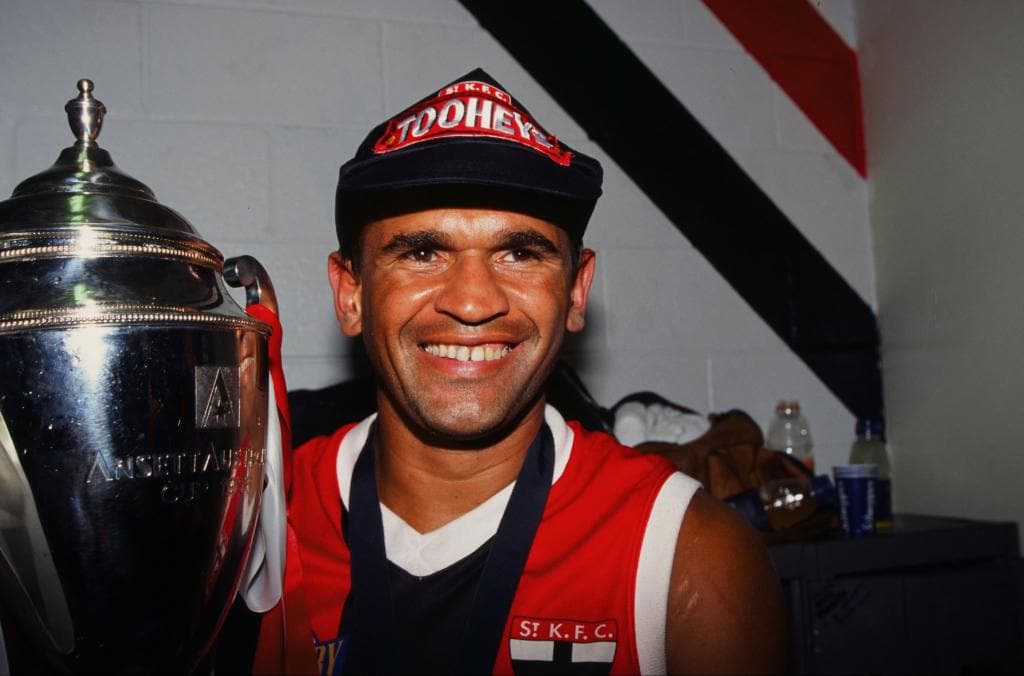
... while Port's Jarrad Schofield (l) and Che Cockatoo-Collins cut loose with 2001's edition.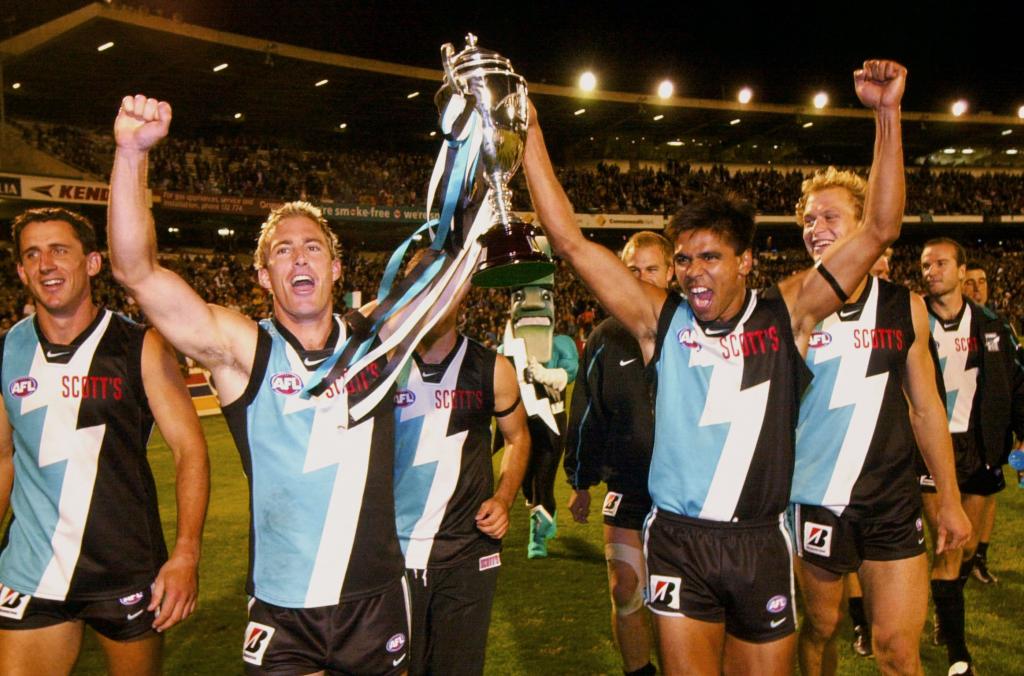
The Crows with 2003's enormous Wizard Cup: part trophy, part soup tureen.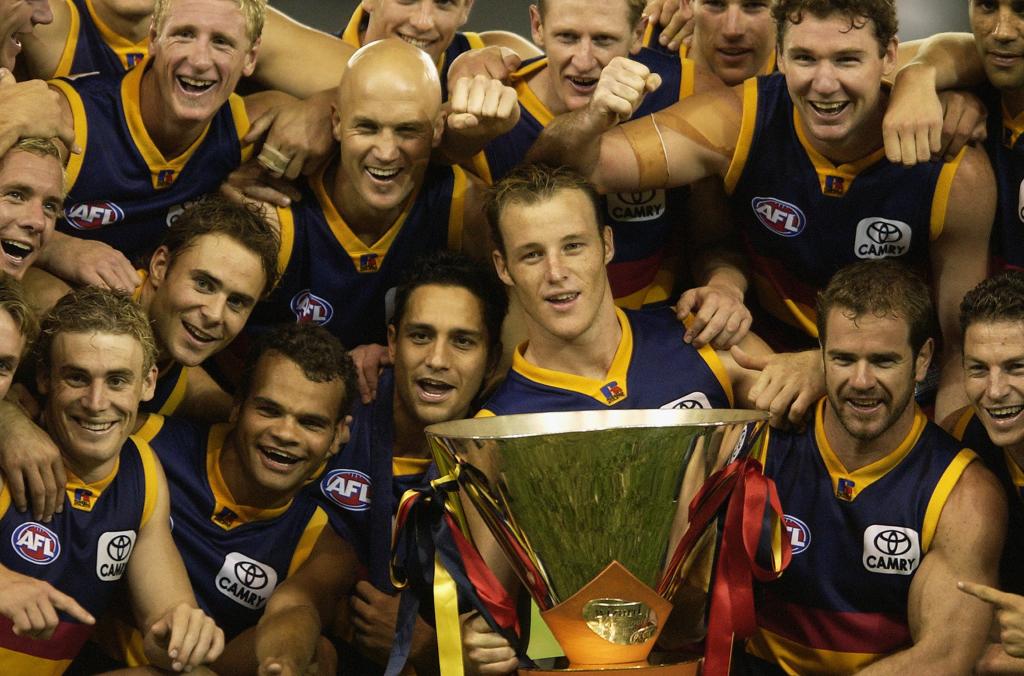
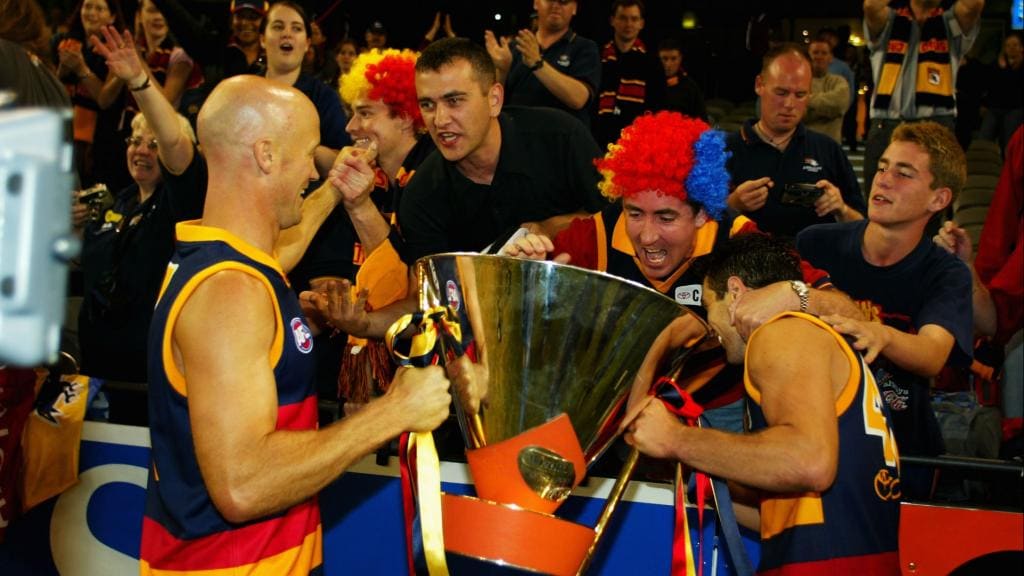
The NAB Cup delivered pre-season silverware to the Bulldogs in 2010 ... 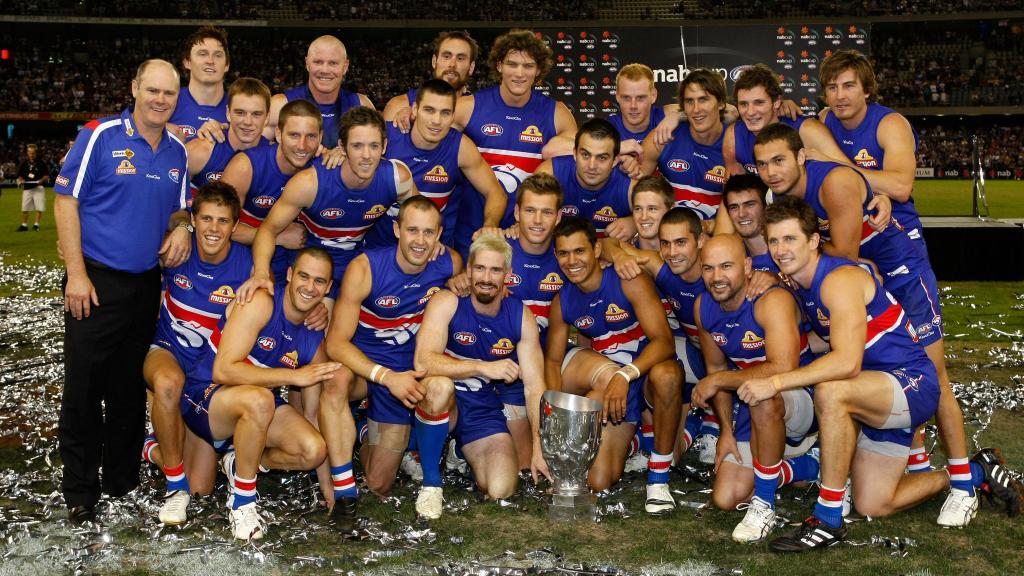
... and Mick Malthouse's Magpies in 2011.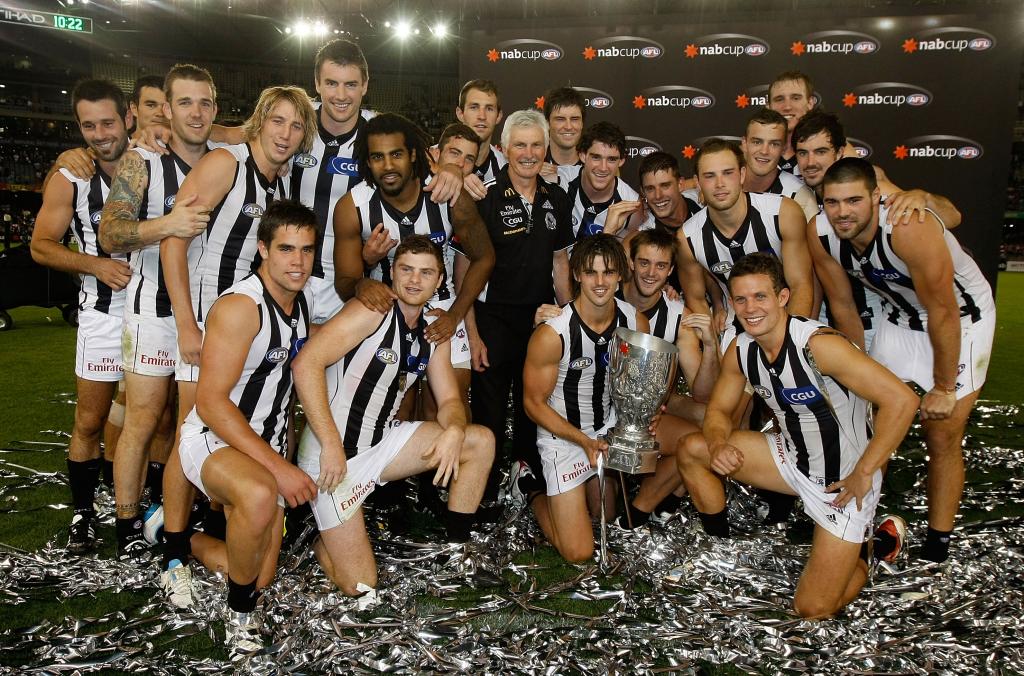
No smiles please, we're Saints
Rules innovations brought further interest and occasional controversy to the series. A different scoring system was embraced in 2003, awarding nine points for a 'super goal' from outside the 50-metre arc and three points for a rushed behind.
And there were memorable moments, including when Hawthorn legend Michael Tuck presented the winner of the medal named in his honour, confidently announcing: "The Norm Smith Medal goes to Brendan Fevola."
Fevola with his Michael Tuck (and not Norm Smith) Medal. 524.jpg)
But it was then-St Kilda coach Grant Thomas who drew attention to the competition's fading glamour.
After guiding his team to success in 2004, Thomas decreed that none of his players smile because they were eyeing a bigger prize.
A granite-faced Grant Thomas with Saint skipper Lenny Hayes and the 2004 Wizard Cup. 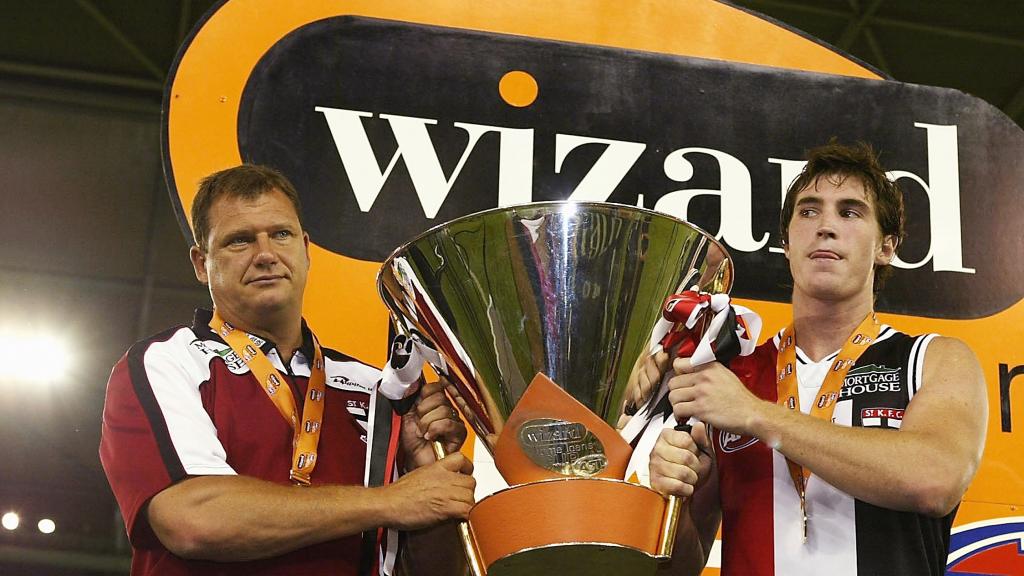
| Season | Grand Final winner | Runner-up | Grand Final crowd |
| 1988 | Hawthorn | Geelong | 35,803 |
| 1989 | Melbourne | Geelong | 48,720 |
| 1990 | Essendon | North Melbourne | 48,559 |
| 1991 | Hawthorn | North Melbourne | 46,629 |
| 1992 | Hawthorn | Fitzroy | 49,453 |
| 1993 | Essendon | Richmond | 75,533 |
| 1994 | Essendon | Adelaide | 43,925 |
| 1995 | North Melbourne | Adelaide | 39,393 |
| 1996 | St Kilda | Carlton | 66,888 |
| 1997 | Carlton | Geelong | 74,786 |
| 1998 | North Melbourne | St Kilda | 63,898 |
| 1999 | Hawthorn | Port Adelaide | 49,874 |
| 2000 | Essendon | North Melbourne | 56,720 |
| 2001 | Port Adelaide | Brisbane Lions | 35,304 |
| 2002 | Port Adelaide | Richmond | 36,481 |
| 2003 | Adelaide | Collingwood | 43,571 |
| 2004 | St Kilda | Geelong | 50,533 |
| 2005 | Carlton | West Coast | 43,391 |
| 2006 | Geelong | Adelaide | 30,707 |
| 2007 | Carlton | Brisbane Lions | 46,094 |
| 2008 | St Kilda | Adelaide | 26,823 |
| 2009 | Geelong | Collingwood | 37,277 |
| 2010 | Western Bulldogs | St Kilda | 42,381 |
| 2011 | Collingwood | Essendon | 45,304 |
| 2012 | Adelaide | West Coast | 27,376 |
| 2013 | Brisbane Lions | Carlton | 24,884 |
Pre-season footy goes regional, and the Lions reign ... and reign
With the pre-season competition expanding to 18 clubs in 2011, the AFL split them into six divisions of three clubs, with each division assembling at a single venue to play shortened, lightning-premiership-style games.
Attendances slowly but steadily declined, and after Michael Voss's Brisbane took out the 2013 pre-season flag, the tournament element was shelved, leaving the Lions with the claim of being the uncontested reigning pre-season premiers.
Ever since, clubs have since played practice matches at a variety of urban and regional venues, taking the game to the far-flung corners of the country.
Though the games have their own flavour, they are a long way from the bright lights and tickertape that, for two-and-a-half decades, gave the pre-season a magic all its own.
We'll hang on to this: Michael Voss (l) and Jonathan Brown with the last NAB Cup. 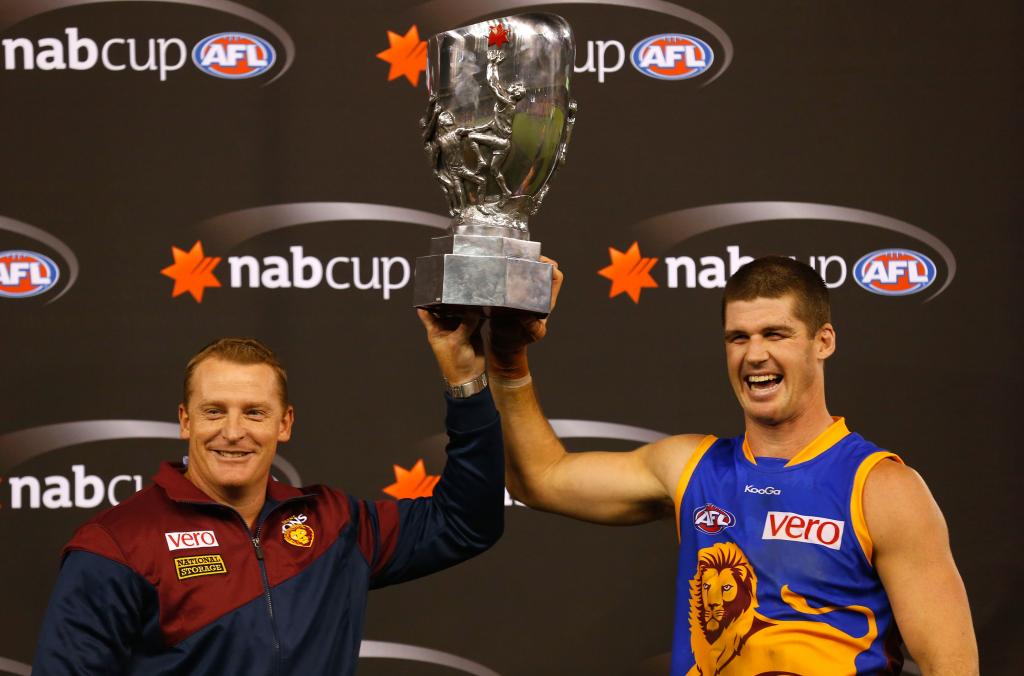
| Competition | Seasons |
| Amco-Herald Cup | 1977-78 |
| Escort Championships | 1979-82 |
| Sterling Cup | 1983-84 |
| Foster's Football Cup | 1985-86 |
| National Panasonic Cup | 1987 |
| Panasonic Cup | 1988-89 |
| Foster's Cup | 1990-94 |
| Ansett Australia Cup | 1995-2001 |
| Wizard Home Loans Cup | 2002-05 |
| NAB Cup | 2006-13 |
| NAB Challenge | 2014-2016 |
| JLT Community Series | 2017-present |
Sources include www.hardballget.net
Read more
RUNNING MAN The runner who worked at nine AFL clubs
FOOTY ON THE EDGE How do you train to play AFLW on an oil rig?


